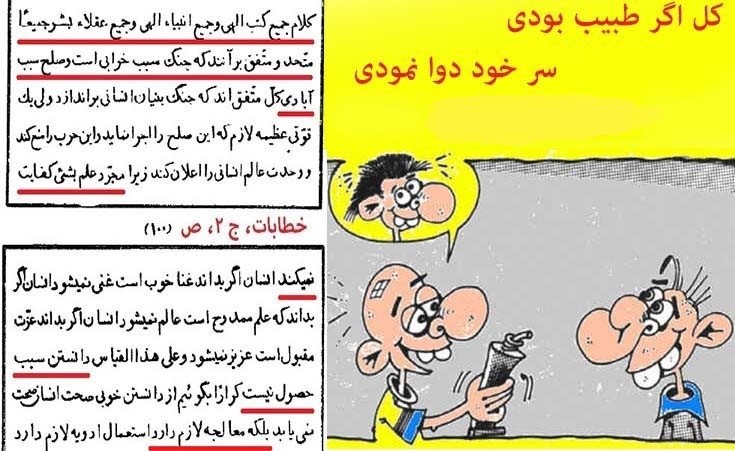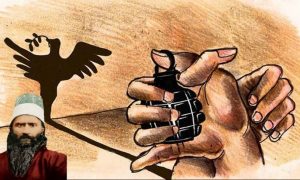Contrary to their actions, the Baha’i leaders have introduced their aims as establishing general peace in their advertisements. However; according to Abdul Baha, shouting the slogan of peace and friendship is not an art and this teaching must be considered as a practical character. So, what has been the Baha’i leaders’ art except for shouting the hollow slogans?!
In their advertisements, the Baha’i cult leaders have introduced establishing general peace as their wish and aim: “Our wish us the oneness of human would and our aim is general peace. Thus, we are united in aim and wish and there aren’t issues in the existence world except for these two ones. Because the oneness of humane world causes honor of human kind and general peace causes tranquility all the ones on the earth. So, we are united in these two aims and there is no other great ones…[۱]”

The Baha’i leaders have introduced their aims ahead of hollow slogans and removing war, fighting and differences to be done by practice and action: “All wise people agree that war causes destruction and peace causes improvement. Everybody believes that war will destroy the humane essence… It won’t be enough for a person to know about a thing. If human being knows wealth is good, he/she won’t be wealthy. If a person knows knowledge is praised, he/she won’t be knowledgeable. If a human being knows honor is acceptable, he/she won’t become honored. Consequently, knowledge about something won’t end in acquiring it.[2]”
Nevertheless, it is interesting to be known that the Baha’ism leaders have repeatedly violated the slogan of peace and friendship. Thus, some cases will be investigated:
۱- Confessed by Abdul Baha, the logic of their leader, Ali Muhammad Shirazi is nothing but massacre and destruction: “In the day when the Excellency the highest emerges, people will beheaded, books and papers will be burnt, tombs will be destroyed and those who oppose him will be massacred.[3]”
۲- Contrary to their peaceable slogans, the Baha’i leaders have confessed running three bloody wars in Iran. The wars which were ran in three parts of Iran motivated and ordered by Bab. Those wars ended inn thousands of people to be injured and killed.[4]
۳- After Ali Muhammad Shirazi death, war and fighting for succession office were done to such an extent that 25 Babis called themselves as the promised one of the book Bayan except for Hussein Ali Nouri and his brother Sobhi Azal.[5] Consequently; regardless of the slogan of peace and friendship, the claimant of Baha’ism prophethood killed his opponents[6]. It is interesting to be noted that the self-proclaimed prophet of Baha’ism didn’t obey Bab’s will concerning Sobhi Azal’s succession[7] and insulted him very much.[8]
۴- The herald of peace and friendship slogan didn’t quit inner fighting; so contrary the self-proclaimed prophet of Baha’ism’s will fought against his brother on the father’s succession[9].
۵- After Abdul Baha’s death, the Baha’ism leaders didn’t follow peace and friendship. Shoqi Effendi and Rouhieh Maxwell fought against the Baha’i self-proclaimed prophet’s leader.[10]
Yes; according to Abul Baha’s speech, peace and friendship slogan and keeping out of fighting are not arts. This teaching must be considered as a practical character of human being. So; except for shouting hollow slogans, what have been the Baha’i leaders’ arts?!
[۱] Ishraq Khawari, the heavenly message, India: Bina, 1986 A.D. p. 52.
[۲] Abbas Effendi, the Sermons, the western Germany; the national assembly of publishing the faith works in Arabic and Persian languages, 127 Badi’a, Vol. 2, pp. 99-100.
[۳] Abbas Effendi, Makatib, Egypt: Kurdistan Al-Elmieh, 1330 A.H., Vol. 2, p. 266.
[۴] Refer to Ishraq Khawari, summary of Nabil (Mataleul Anwar), Mer’at publishing and printing institute, pp. 330, 345, 346 and 334.
[۵] Muhammad Ali Feizi, the Excellency Bahaullah, the Western Germany: National assembly of publishing the faith works in Persian and Arabic languages, 1990 A.D. pp. 103-104.
[۶] Refer to Ezzieh Nouri, Tanbihunnaemin, the faithful of the Bayan, the electronic copy, pp. 11-12.
[۷] Refer to Mirza Jani Kashani, Noqtatul Kaff, Netherland, Breil publishing house, 1910 A.D. The book introduction, p. 19; Ali Muhammad Shirazi, a part of tablets of Noqteh Oula to Agha Seyyed Hussein Kateb, Tehran: Babian Publications, 1337 S.H. p. 13
[۸] Ishraq Khawari, Rahiq Makhtoum, the electronic copy p. 172.
[۹] Refer to Abbas Effendi, Makatib, Al-Elmieh Al-Egypt publishing house: Attempted by Farajullah Zakiul Kurdi, 1330 A.H., Vol. 1, pp. 442-443.
[۱۰] For more studies refer to the article: Shoqi Effendi’s insulting to the Baha’i proselytizers!






